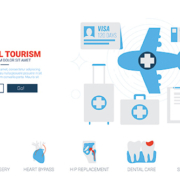Medical tourism – reversing traditional trends, quality and innovation in developing countries
Medical tourism refers to people who travel overseas for obtaining treatment. In the past, it referred to (wealthy/privileged) patients from developing countries who visited medical centres in industrialized countries to get treatment not available at home.
However, the situation has since reversed, in certain cases dramatically. Medical tourism now typically refers to patients from industrialized countries who travel to poorer countries for lower priced, or more quickly available (and in some cases, superior) treatment. Top medical tourist destinations in this respect include India and Thailand as well as Costa Rica, Mexico and the Gulf.
Medical tourism and health tourism
Some studies do not consider medical tourism to include cosmetic and wellness tourism – with dental treatment also viewed as a cosmetic procedure. This, larger group is often referred to as health tourism.
Market revenues for a major medical tourism destination, Thailand, include a relatively large number of cosmetic surgery procedures. This segment also includes a multitude of places in south America, with the industry’s maturity fed by bustling local demand. For example, according to the Sociedad Boliviana de Cirugia Plastica y Reconstructiva’, over 70percent of middle and upper class women in the country have had plastic surgery.
India leads in higher-end procedures
Conversely, at the other end, if only surgical procedures for overseas patients are included, India leads the global medical tourism market.
Consultants McKinsey estimated 180,000 medical tourists were treated at Indian facilities in 2004 (up from 10,000 just five years earlier). Arrivals have since been rising sharply and are estimated to have reached 250,000 in 2012, contributing 3 billion USD in revenues. This is effectively about 30percent of the global market, estimated for the year at 10.5 billion USD by Transparency Market Research.
India has proven to be a preferred destination for US and UK patients, in particular, because of the use of English in most professional interactions, as well as the fact that both countries have a large number of Indian-origin physicians. Indeed, the US government’s top medic, the Surgeon General, is Vivek Hallegere Murthy, a 40-year old Indian.
India stands out as an interesting destination in another respect. Its massive generic drugs industry provides post-operative medicinal treatment at prices well below the West.
Market drivers: cost, waiting times, accreditation
Key factors driving medical tourism from the West to developing countries include the high cost of healthcare and increasing waiting times for certain procedures. Insurance in several countries often does not cover 100percent of the costs of common age-related requirements such as a knee or hip replacement, or limits the choice of the prosthetics, or the surgeon and facility.
Accreditation of top hospitals in medical tourism destinations has also fuelled demand. The oldest international accrediting body is Accreditation Canada, which has accredited hospitals in about a dozen countries.
The best known accreditation group, however, is Joint Commission International (JCI) in the US. JCI was set up in 1994 to provide international clients education and consulting services, and several international hospitals now see accreditation as a way to attract American patients. JCI is an independent private, not-for-profit organization that seeks to develop nationally and internationally recognized procedures to help improve patient care and safety. It advises hospitals to meet standards for patient care and then accredits hospitals meeting the standards.
A British scheme, QHA Trent Accreditation, is an active independent holistic accreditation scheme. Another is GCR.org, which monitors success metrics and standards of almost 500,000 medical clinics worldwide.
These schemes vary in quality, size and cost to hospitals making use of them.
Increasingly, hospitals are looking towards dual international accreditation, perhaps having both JCI to cover potential US clientele, and Accreditation Canada or QHA Trent for Canadian and British patients.
Indian price advantage boosted by quality, innovations
Practically all surgery procedures performed in medical tourism destinations cost a fraction of what they do in industrialized countries. For example, while a liver transplant in the US costs about 300,000 USD ( Euro 280,000), the figure in India is 50,000 USD ( Euro 47,000). Open heart surgery in India costs between 3,000 ( Euro 2,800) and 10,000 USD ( Euro 9,400), compared to 70,000 USD ( Euro 65,500) in the UK and 150,000 USD ( Euro 140,000) in the US.
Such figures acquire added value when one reviews the conclusions of a Harvard Business School (HBS) study in November 2013, comparing data on angioplasty in the US versus India. The study found that one in 200 US angioplasty patients required emergency surgery, with half of them dying, while only two of 40,000 angioplasty patients at India’s CARE Hospitals required emergency surgery, with just one death in the OR since the hospital’s inception in 1997.
The HBS study also studied other Indian hospitals and interventions, finding them to be on par or better than their US counterparts – for example, Apollo Hospitals with knee, coronary and prostate surgery as well as for infections related to the operating theatre and catheters, Narayana for coronary artery bypass procedures, Deccan for peritoneal dialysis and Aravind for ophthalmology.
The HBS review noted India was not simply an improver but an innovator too, for example Indian doctors pioneered the beating-heart method of surgery, where they operate without shutting patients’ hearts down via a heart-lung machine, leading to fewer complications, shorter hospital stays and quicker recovery.
New segment of intra-Third World medical tourism
While much attention remains on Western medical tourists, one of the fastest growing market segments consists of patients within the Third World, who travel to more advanced developing countries. India again is at the top of the list. In early Dec 2016 / Jan 2017, for instance, it was announced that Iman Abdulati, a 36-year old woman weighing half a tonne, was to be flown to India from her home in Egypt for bariatric surgery.
Such cases have drawn considerable attention for other, political reasons.
Pakistani patients with severe conditions requiring top-notch treatment are a routine media fixture in India. For example, in September 2016, Pakistan’s Express Tribune’ featured the case of Abdul Basit, an 11-year old boy who had been suffering from the rare condition known as Crigler-Najjar syndrome and went for a liver transplant to India. Two years previously, after complications, the wife of former Afghan President Hamid Karzai gave birth to a girl at Fortis Hospital in New Delhi.
In August 2016, The Diplomat’ reported India had emerged as one of the fastest growing global healthcare destinations, particularly for patients from conflict countries like Afghanistan, Iraq, Yemen, Sudan, the Democratic Republic of Congo (DRC), and Somalia, attracting close to 400,000 foreign patients a year, half from war-ravaged countries.
The selection of India as preferred medical tourism destination is being officially sanctioned. In 2004, BBC News’ reported that ‘India was chosen as the place’ for sending sick patients from Tanzania unable to be treated at home, after the Tanzanian government ‘did a comparative analysis of health facilities in South Africa, India and western European countries.’ In 2007, Companion Global Healthcare teamed up with hospitals in India (as well as Thailand and Singapore).
China lags India due to egalitarian healthcare model
Due to a variety of reasons, the other Asian behemoth, China, has a much less mature medical tourism sector. WHO figures show hospital bed densities far lower in India, at just 9 per 10,000 people (making a total of roughly 1 million beds) compared to 42 in China (about 5 million). However, the higher share of private beds in India (40percent against 6.5percent in China) means that India has slightly more private beds – about 400,000, against China’s 325,000.
More than anything, India’s lead over China in medical tourism symbolises its top-down approach to healthcare, in contrast to China’s bottom-up one which first aims at providing top quality healthcare to local Chinese. As a result, China does not provide good healthcare for its middle and upper class. For Britain’s Guardian’, poor rural Chinese were curiously’ better off than their city cousins.’ The Guardian’ contrasted this with India, where ‘many city-based healthcare facilities are excellent….’ This higher-end focus provides India with more medical tourists than China.
Hospital budgets: the sky’s the limit
There are now at least a dozen major private hospital groups in India. Leading groups (with 20-50 facilities, and 2,500-8,000 beds) include Apollo, Max Healthcare, Fortis, Escorts Healthcare, Wockhardt and the Manipal Group. Many of the above (as well as newcomers from cash-rich Indian conglomerates such as Reliance, the Hindujas, Sahara and ITC) are also pursuing the new concept of Medicities, involving suburban developments dedicated wholly to integrated hospital facilities.
The procurement budget of such groups is not insignificant. Apollo’s annual spending on medical equipment, for example, has been close to 200 million USD in recent years. Such budgets allows cash-rich Indian hospitals to procure state-of-the-art equipment – from Da Vinci robots and stereotactic laser surgery to wide-bore 3T Silent Scan MRIs.
Nevertheless, as far as spending is concerned, Indian hospital groups face several challenges in the coming years, especially from the cash-flush Gulf.
US hospitals lead Gulf partnerships
US hospitals are at the forefront of partnerships in the Gulf. One of the key reasons was the difficulty for medical tourists from the region to obtain US visas after 9/11, according to the American Hospital Association.
Key US partners of Gulf hospitals include Johns Hopkins Medicine, which has an agreement since 2006 to partner the General Health Authority for Health Services in the UAE. It also manages the 400-plus bed Tawam Hospital in Abu Dhabi and an affiliated centre offering state-of-the-art molecular imaging services. Johns Hopkins also has alliances with King Khaled Eye Specialist Hospital in Saudi Arabia.
Another example is the Cleveland Clinic, which is affiliated with the International Medical Centre in Jeddah, Saudi Arabia, and is a strategic partner at the 360-bed, multi-specialty Cleveland Clinic Abu Dhabi Hospital in the UAE.
Elsewhere in the UAE, Methodist International manages the operations of Burj Dubai Medical Centre as well as clinics in Dubai, while Partners Harvard Medical International is a key strategic collaborator with Dubai Healthcare City (which explicitly seeks to attract foreign medical tourists).
Education and training focus in Gulf
Many of these alliances are increasing their focus on education and training. For example, the Partners-Dubai Healthcare City has added a high profile unit called Harvard Medical School Dubai Center Institute for Postgraduate Education and Research, while in 2014 Johns Hopkins signed a partnership with oil major Aramco to provide medical education and training in Saudi Arabia.
Qatar, too, has sought US partners. The Weill Cornell Medical College was in fact one of the earliest ventures, established in 2001 as a partnership between Cornell University and the Qatar Foundation for Education, Science and Community Development. It aims to provide medical education and cutting-edge research.
Ironically, the focus on training might hit a traditional source of physicians in the Gulf especially hard, namely Indians who would be replaced by skilled locals.


